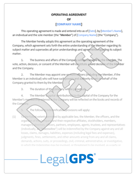Legal Considerations for E-Commerce Sites: Protecting Your Business Online
Setting up an e-commerce website requires more than just technical know-how and marketing savvy; there are several legal considerations you must take...
6 min read
LegalGPS : Oct. 17, 2024
In the world of e-commerce, a well-crafted return policy is more than just a formality—it's a powerful tool that can influence customer trust, sales conversions, and brand loyalty. A clear and effective return policy can help turn potential customers into loyal advocates by providing a sense of security and reliability. On the other hand, a vague or overly strict return policy can deter purchases and hurt your brand reputation. In this guide, we'll dive into best practices for crafting return policies that not only meet your business needs but also resonate with customers.


Legal GPS Pro
Protect your business with our complete legal subscription service, designed by top startup attorneys.
Before we get into how to create a successful return policy, let’s talk about why it matters. A strong return policy is crucial for several reasons:
Building Trust: Customers are more likely to buy from you if they know they can return items easily. It reduces perceived risk and makes them feel comfortable making a purchase.
Boosting Conversion Rates: A generous return policy can increase conversions. It assures customers that if something goes wrong, they have options to get their money back or exchange the product.
Reducing Negative Reviews: A clear return policy prevents confusion and dissatisfaction, helping reduce the likelihood of negative reviews from frustrated customers.
Enhancing Customer Loyalty: Offering hassle-free returns can turn a negative experience into a positive one, which helps build loyalty and encourages repeat business.
To craft an effective return policy, there are key elements that you need to consider. Here are some critical components every e-commerce return policy should include:
Specify the timeframe in which customers can return items. Common return windows are 30, 60, or 90 days from the purchase date.
Best Practice: A 30-day return window is generally standard, but longer periods (such as 60 or 90 days) can give customers more confidence. Be clear about whether this timeframe starts from the purchase date, delivery date, or some other milestone.
Sample Clause: "We accept returns within 30 days of the delivery date. Items returned after 30 days will not be eligible for a refund or exchange."
Clearly outline the condition items must be in to qualify for a return. This helps prevent disputes.
Best Practice: Include phrases like "unused and in original packaging" or "items must be in resellable condition." Be explicit if certain products (e.g., electronics, personal items) must be unopened.
Sample Clause: "Items must be returned in their original condition, unworn, unwashed, and with all tags attached. Products that show signs of use will not be accepted."
Sales Tax Obligations for E-Commerce
List any items that are non-returnable or have special conditions for returns. Common exceptions include final sale items, gift cards, or personalized products.
Best Practice: Highlight exceptions prominently in your policy to avoid surprises. Consider adding a separate section dedicated to non-returnable items to keep it clear.
Sample Clause: "Please note that personalized items, gift cards, and final sale items are not eligible for return or exchange."
Specify whether customers are responsible for return shipping costs or if your company will cover them.
Best Practice: Offering free returns is a great way to boost customer confidence, but if you can’t offer this universally, be clear about the associated costs. You might consider offering free returns only for exchanges or store credit to strike a balance.
Sample Clause: "Customers are responsible for return shipping costs. However, we offer free shipping on exchanges or if store credit is chosen as the refund method."
Explain how refunds will be processed. Customers want to know if they’ll receive a refund to their original payment method, store credit, or an exchange.
Best Practice: Clearly state the options available and the timeline for processing refunds. For example, “Refunds will be issued to the original payment method within 5-7 business days after receiving the returned product.”
Sample Clause: "Refunds will be processed to the original payment method within 7 business days after we receive and inspect the returned item. Store credit refunds are processed immediately upon approval."
Provide clear instructions on how customers can initiate a return. This includes information on contacting your support team, filling out a return form, or accessing a returns portal.
Best Practice: Include a step-by-step guide for initiating a return, and make it as simple as possible. If you offer prepaid return labels, mention that here.
Sample Clause: "To initiate a return, please visit our Returns Center at [website link] and enter your order number and email address. You will be provided with a prepaid return label and instructions on how to send your item back."
A customer-friendly return policy can be the difference between a sale and an abandoned cart. Here are some tips to make sure your policy is effective:
Your return policy should be easy to locate on your website. A customer should never have to dig through multiple pages to find it.
Best Practice: Add a link to your return policy in your website footer, checkout page, and FAQ section. Also, consider including a link in order confirmation emails.
Sample Clause: "Our return policy is available at the bottom of every page on our website, as well as in your order confirmation email."
Avoid using legal jargon or overly complex language. Your return policy should be written in plain, customer-friendly language that is easy to understand.
Example: Instead of saying, “Returns must be effectuated within thirty (30) calendar days,” you can say, “You can return your item within 30 days of delivery.”


Legal GPS Pro
Protect your business with our complete legal subscription service, designed by top startup attorneys.
Show customers that your return policy is designed to make their shopping experience better. Highlight any customer-friendly features like free returns, extended return periods, or easy exchanges.
Example: “We offer hassle-free returns and exchanges within 60 days to ensure you’re completely satisfied with your purchase.”
Manage customer expectations by being transparent about the return process, timelines, and any associated costs.
Best Practice: Include a timeline for when they can expect their refund or exchange to be processed, and mention any factors that could cause delays.
Sample Clause: "Refunds may take up to 10 business days to process, depending on your financial institution. We will notify you via email once your return has been received and your refund has been processed."
To reduce return rates and keep customers engaged, consider offering alternatives to full refunds, such as store credit or exchanges. This can also help keep revenue in your business.
Best Practice: Offer an incentive, such as a small bonus credit, for customers who choose store credit over a refund. For instance, “Choose store credit and receive an additional 10% off your next purchase.”
Sample Clause: "If you opt for store credit instead of a refund, you will receive an additional 10% credit as a thank-you for supporting our store."
To help you get started, let’s take a look at some examples of effective return policies from successful e-commerce brands:
Zappos: Known for their 365-day return policy and free returns, Zappos uses its return policy as a key differentiator to build customer trust and loyalty.
Warby Parker: Warby Parker offers free returns and exchanges within 30 days for their glasses, plus free shipping both ways, which makes the return process simple and risk-free for customers.
ASOS: ASOS provides clear instructions for initiating a return and offers multiple return options, including prepaid return labels, making it easy for customers to choose what works best for them.
Even well-intentioned return policies can go wrong if they aren’t properly crafted. Here are some common mistakes to avoid:
A vague return policy can lead to confusion and frustration. Make sure all aspects of the return process are clearly defined to avoid misunderstandings.
Overly restrictive policies, like short return windows or “no returns” policies, can turn away customers. Even if you’re trying to reduce return rates, a customer-friendly approach can lead to more sales overall.
Customers need easy access to your return policy. If it’s buried deep within your website, it will frustrate users and hurt conversions.
To help you get started, here’s a quick checklist for crafting your return policy:
Define Your Return Window: Choose a timeframe that fits your business model (e.g., 30, 60, or 90 days). Specify whether it starts from the delivery date, purchase date, or another milestone.
Clarify Conditions: Clearly state the condition items must be in to qualify for a return (e.g., unused, in original packaging, with tags attached).
List Non-Returnable Items: Highlight any exceptions and non-returnable items, such as personalized products, gift cards, or final sale items.
Explain Return Costs: Be transparent about who is responsible for return shipping costs, and if there are any conditions for free returns.
Describe Refund Methods: Detail how refunds will be processed (e.g., original payment method, store credit), and provide a timeline for processing.
Provide Instructions: Include step-by-step instructions for initiating a return, and mention if prepaid return labels are offered.
Highlight the Benefits: Emphasize any customer-friendly features, such as free returns, extended return periods, or exchange incentives.
Use Simple Language: Avoid legal jargon; use clear and concise language that is easy for customers to understand.
Make It Easy to Find: Ensure your return policy is easily accessible from multiple locations on your website, including the footer, FAQ, and order confirmation emails.
An effective return policy is an essential component of your e-commerce business strategy. It not only helps build trust with potential customers but also enhances the overall shopping experience, increasing the likelihood of repeat business. By being clear, customer-friendly, and transparent, you can craft a return policy that works for both your customers and your bottom line. Remember, a great return policy is not just about managing returns—it’s about fostering loyalty and confidence in your brand.
The biggest question now is, "Do I need a business lawyer?” For most businesses and in most cases, you don't need a lawyer to start your business. Instead, many business owners rely on Legal GPS Pro to help with legal issues.
Legal GPS Pro is your All-In-One Legal Toolkit for Businesses. Developed by top startup attorneys, Pro gives you access to 100+ expertly crafted templates including operating agreements, NDAs, and service agreements, and an interactive platform. All designed to protect your company and set it up for lasting success.

Legal GPS Pro
Protect your business with our complete legal subscription service, designed by top startup attorneys.

100+ legal templates, guides, and expert advice to protect your business.
Trusted by 1000+ businesses
Table of Contents

Setting up an e-commerce website requires more than just technical know-how and marketing savvy; there are several legal considerations you must take...

E-commerce contracts are essential agreements that help protect your business, manage risks, and establish clear expectations with customers,...

Running an e-commerce business might seem straightforward—until you hit the legal stuff. Terms & Conditions (T&Cs) can feel like one of those...